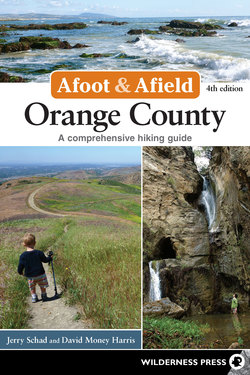Читать книгу Afoot and Afield: Orange County - Jerry Schad - Страница 17
На сайте Литреса книга снята с продажи.
Оглавлениеchapter 2
Upper Newport Bay
The marshes surrounding Upper Newport Bay represent tiny remnants of a much more extensive wetland that once stretched inland to the present city of Tustin. The Portolà expedition of 1769 (led by Gaspar de Portolà) and subsequent travelers passing up or down the coast avoided this soggy region and stuck to the base of the foothills, where the firm ground more than made up for the inconvenience of traversing ridges and ravines.
During the past 100,000 years or more, the Santa Ana River has wandered across the surface of the Los Angeles Basin, changing course many times in response to flooding and silt deposition. Around 30,000 years ago, the river (which at that time carried more runoff because of a wetter climate) carved out the basic form of the troughlike structure now occupied by Upper Newport Bay. Sediment carried by the river and dropped at the mouth of the trough formed a barrier island, today’s Balboa Peninsula, enclosing (lower) Newport Bay.
The most recent natural shift in the Santa Ana River’s course occurred in 1825, when a large flood redirected the flow west from Upper Newport Bay to essentially the place where it now reaches the ocean via artificial channel. Today the bay is fed by San Diego Creek, a small former tributary of the river.
For many millennia, decayed marsh vegetation (peat) accumulated along the upper bay shores. This material, mixed with fine silt washed down from the surrounding slopes and bluffs, has created soil conditions conducive to self-sustaining wetlands.
Hemmed in by bustling traffic arteries, high-rise office buildings, residential areas, and the Irvine campus of the University of California, Upper Newport Bay exists in a kind of time warp. Coyotes and mule deer still roam the periphery, while myriads of migratory birds use the productive marshes as a stopover or winter home.
Birds love saltwater wetlands.
The future of the wetlands around Upper Newport Bay has been assured by the establishment of three protected areas. One of them, the Upper Newport Bay Ecological Reserve, encompasses most of the bay’s saltwater marshes. Just upstream along the channelized San Diego Creek are two more areas, protecting only a fraction of the freshwater marsh that once extended inland for several miles. Some 200 acres of the marsh became UC Irvine’s San Joaquin Freshwater Marsh Reserve in 1970, now managed as a research reserve accessible only to qualified researchers. The adjacent and newer San Joaquin Wildlife Sanctuary, on the other hand, has been designed for extensive use by recreationalists and amateur naturalists. An amazing 10 miles of wide, smoothly graded trails crisscross the wildlife sanctuary, which covers 300 acres of diked ponds, natural riparian habitat, and artificially created native habitats.
Buck Gully is part of the Newport Beach trail system. Although it doesn’t really fit in with the other waterfront trails, the lovely trail is included in this chapter for lack of a more suitable home.
